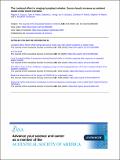Files in this item
The Lombard effect in singing humpback whales : source levels increase as ambient ocean noise levels increase
Item metadata
| dc.contributor.author | Guazzo, Regina A. | |
| dc.contributor.author | Helble, Tyler A. | |
| dc.contributor.author | Alongi, Gabriela C. | |
| dc.contributor.author | Durbach, Ian N. | |
| dc.contributor.author | Martin, Cameron R. | |
| dc.contributor.author | Martin, Stephen W. | |
| dc.contributor.author | Henderson, E. Elizabeth | |
| dc.date.accessioned | 2020-09-17T15:30:02Z | |
| dc.date.available | 2020-09-17T15:30:02Z | |
| dc.date.issued | 2020-08-04 | |
| dc.identifier | 269924508 | |
| dc.identifier | 8480254a-fe48-4368-8b41-c2e7e1d0c8a2 | |
| dc.identifier | 85089726238 | |
| dc.identifier | 000560024200001 | |
| dc.identifier.citation | Guazzo , R A , Helble , T A , Alongi , G C , Durbach , I N , Martin , C R , Martin , S W & Henderson , E E 2020 , ' The Lombard effect in singing humpback whales : source levels increase as ambient ocean noise levels increase ' , Journal of the Acoustical Society of America , vol. 148 , no. 2 , pp. 542-555 . https://doi.org/10.1121/10.0001669 | en |
| dc.identifier.issn | 0001-4966 | |
| dc.identifier.other | ORCID: /0000-0003-0769-2153/work/79918510 | |
| dc.identifier.uri | https://hdl.handle.net/10023/20640 | |
| dc.description | Funding: Office of Naval Research (Code 322, Marine Mammals and Biology), Commander, U.S. Pacific Fleet (Code N465JR), and the Naval Facilities Engineering Command Living Marine Resources Program. | en |
| dc.description.abstract | Many animals increase the intensity of their vocalizations in increased noise. This response is known as the Lombard effect. While some previous studies about cetaceans report a 1 dB increase in the source level (SL) for every dB increase in the background noise level (NL), more recent data have not supported this compensation ability. The purpose of this study was to calculate the SLs of humpback whale song units recorded off Hawaii and test for a relationship between these SLs and background NLs. Opportunistic recordings during 2012-2017 were used to detect and track 524 humpback whale encounters comprised of 83 974 units on the U.S. Navy's Pacific Missile Range Facility hydrophones. Received levels were added to their estimated transmission losses to calculate SLs. Humpback whale song units had a median SL of 173 dB re 1 μ Pa at 1 m, and SLs increased by 0.53 dB/1 dB increase in background NLs. These changes occurred in real time on hourly and daily time scales. Increases in ambient noise could reduce male humpback whale communication space in the important breeding area off Hawaii. Since these vocalization changes may be dependent on location or behavioral state, more work is needed at other locations and with other species. | |
| dc.format.extent | 14 | |
| dc.format.extent | 3181904 | |
| dc.language.iso | eng | |
| dc.relation.ispartof | Journal of the Acoustical Society of America | en |
| dc.subject | GC Oceanography | en |
| dc.subject | QA Mathematics | en |
| dc.subject | QH301 Biology | en |
| dc.subject | Acoustics and Ultrasonics | en |
| dc.subject | NDAS | en |
| dc.subject.lcc | GC | en |
| dc.subject.lcc | QA | en |
| dc.subject.lcc | QH301 | en |
| dc.title | The Lombard effect in singing humpback whales : source levels increase as ambient ocean noise levels increase | en |
| dc.type | Journal article | en |
| dc.contributor.institution | University of St Andrews. School of Mathematics and Statistics | en |
| dc.contributor.institution | University of St Andrews. Centre for Research into Ecological & Environmental Modelling | en |
| dc.identifier.doi | 10.1121/10.0001669 | |
| dc.description.status | Peer reviewed | en |
This item appears in the following Collection(s)
Items in the St Andrews Research Repository are protected by copyright, with all rights reserved, unless otherwise indicated.

